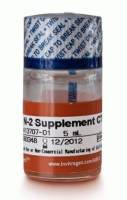Generation and Characterization of Bispecific Tandem Diabodies for Tumor Therapy
互联网
835
Bispecific antibodies (BsAb) provide an effective means of retargeting cytotoxic effector cells against tumor cells ( 1 ). They have mainly been produced using murine hybrid hybridomas ( 2 ) or by chemical crosslinking ( 3 , 4 ). However, the immunogenicity of BsAb derived from rodent monoclonal antibodies (MAbs) is a major drawback for clinical use ( 5 ). They are also difficult to produce and purify in large quantities. Recent advances in recombinant antibody technology have provided several alternative methods for constructing and producing BsAb molecules ( 6 ) (Fig. 1 ). For example, single chain Fv (scFv) fragments have been genetically fused with adhesive polypeptides ( 7 ) or protein domains ( 8 ) to facilitate the formation of heterodimers (Fig. 1A ). The genetic engineering of scFv-scFv tandems linked with a third polypeptide linker has also been carried out in several laboratories ( 9 , 10 ) (Fig. 1B ). A bispecific diabody was obtained by the non-covalent association of two single chain fusion products consisting of the V H domain from one antibody connected by a short linker to the V L domain of another antibody ( 11 , 12 ) ( see Chapter 18 of Arndt and Krauss in this issue) (Fig. 1C ). The two antigen binding domains have been shown by crystallographic analysis to be on opposite sides of the diabody such that they are able to crosslink two cells ( 13 ). However, the co-secretion of two hybrid scFv fragments can give rise to two types of dimer: active heterodimers and inactive homodimers. A second problem is that the two chains of diabodies are held together by noncovalent associations of the V H and V L domains and can diffuse away from one another. Moreover, to ensure the assembly of a functional diabody, both hybrid scFv fragments must be expressed in the same cell in similar amounts. This latter requirement is difficult to uphold in eukaryotic expression systems such as yeast, which are often preferred because high yields of enriched product can be obtained ( 14 , 15 ). Finally, the small size of bispecific diabodies (50–60 kDa) leads to their rapid clearance from the bloodstream through the kidneys, thus requiring the application of relatively high doses for therapy. In contrast to native antibodies, all of the aforementioned bispecific molecules have only one binding domain for each specificity. However, bivalent binding is an important means of increasing the functional affinity and possibly the selectivity for particular cell types carrying densely clustered antigens.
Fig. 1. Schematic representation of Fv-based bispecific recombinant antibody constructs and their genes. ( A ) Bispecific miniantibody assembled from dimerization cassettes based either on leucine zippers (Jun and Fos) ( 7 ) or on the antibody first constant domains (C H 1 and CL) ( 8 ). In this case, two scFv antibody fragments of different specificities (A and B) are fused to adhesive self-associating peptide or protein domains (AD). ( B ) Bispecific scFv-scFv tandem [(scFv) 2 ] and four-domain gene construct for its production. ( C ) Bispecific diabody formed by non-covalent association of two hybrid scFv fragments consisting of V H and V L domains of different specificities. ( D ) Single chain fourdomain gene construct for production of dimeric or tetrameric bispecific molecules. Depending on the linker length, either single-chain diabody (left), or tetravalent tandem diabody (right) can be formed. Antibody variable domains (V H , V L ), peptide linkers ( L ) and antigen-binding sites (A or B) of Fv modules are indicated. The locations of promoter/operator ( p/o ), ribosome binding sites (rbs), and signal peptides for secretion in bacteria (SP) are also shown.







